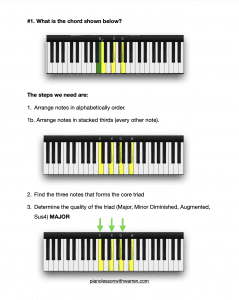Today, we delve into the intriguing world of major seventh and dominant seventh chords. These chords, while similar in construction, offer distinctly different applications in music. So, let’s explore these chords and learn how to effectively incorporate them into your playing.
Understanding the Major Seventh Chord
The major seventh chord is a beautiful, four-note chord. It consists of a major third, perfect fifth, and a major seventh. Here’s an easy way to visualize and build it, especially for beginners:
- Start with a major chord.
- Go to the octave of that chord.
- Lower the octave note by a half-step.
For example, take C major. Play the C octave and then lower the higher C by a half step to B. You now have a C major seventh chord. This method works for any major chord and is a beginner-friendly way to approach these chords.
Another way to look at the major seventh chord is by adding a major third interval on top of the fifth note of the major chord. Remember, a major third is made up of four semitones.
Applications of the Major Seventh Chord
In a major key, you’ll often find the major seventh used on the one chord and the four chord. For instance, in the key of C major, the C major seventh and F major seventh are common. When voicing these chords, you can play the root in the left hand and the seventh, third, and fifth in the right hand. Adding the ninth to these chords can give them a silkier sound.
Exploring the Dominant Seventh Chord
The dominant seventh chord is similar to the major seventh chord, with one key difference: the seventh note is lowered by a full step instead of a half step. Here’s how you can build a dominant seventh chord:
- Start with a major chord.
- Take the octave of the root note.
- Lower the octave note by a whole step (or two half-steps).
For example, take D major. Play the D octave and then lower the higher D by a whole step to C. You now have a D dominant seventh chord.
The dominant seventh chord is composed of a major third, perfect fifth, and a minor seventh. This chord naturally creates a tension that wants to resolve up a fourth.
Applications of the Dominant Seventh Chord
Dominant seventh chords are a staple in blues music, often used in the classic 12-bar blues progression. They can also function as secondary dominants, creating temporary tension that resolves to another chord a fourth away.
Conclusion and Practice Tips
Both the major seventh and dominant seventh chords are similar in construction but serve very different purposes in music. Experiment with these chords, try different voicings, and see how they can enhance your playing.
If you have any questions or need further guidance, feel free to reach out to me. Don’t forget to practice regularly and explore these chords in different keys. Stay tuned for more tutorials on piano lessons with Warren McPherson, and happy playing!
Download The 7 Steps To Naming ANY Chord PDF For FREE
With this PDF, you NEVER HAVE TO GUESS what chord you’re playing.


